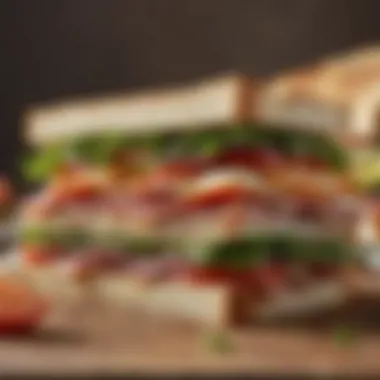Mastering the Art of Sandwich Preparation: A Complete Guide


Recipe Overview
Name: The Ultimate Gourmet Sandwich
Yield: 4 portions
Preparation Time: 15 minutes
Cooking Time: 5 minutes
Difficulty Level: Easy
Main Ingredients:
- Freshly baked ciabatta bread
- Roasted turkey breast
- Aged cheddar cheese
- Avocado slices
- Spicy mustard
- Mixed greens
Step-by-Step Instructions
- Prep Your Ingredients:
- Build the Sandwich:
- Grill (Optional):
- Cut and Serve:
- Start by slicing the ciabatta bread lengthwise. Ensure your knife is sharp to get clean cuts.
- Turkey can be sliced thinly if necessary. Wash the mixed greens and dry gently using a salad spinner or paper towels.
- Cut the avocado in half, remove the pit, and slice it into thin pieces.
- Spread a generous layer of spicy mustard on both sides of the ciabatta.
- Begin layering: first, place a layer of turkey slices, covering the bottom completely.
- Follow with a slice of aged cheddar, next add a few slices of avocado, and then some mixed greens for freshness.
- Close the sandwich with the top half of the ciabatta.
- For added flavor, grill the sandwich on a skillet for approx. 2-3 minutes on each side, or until golden brown.
- Press down gently with a spatula. This promotes the melting of cheese.
- Cut the sandwich diagonally for presentation. Serve with chips or a side salad.
Quick Tip: Assemble your sandwiches the night before for a no-fuss lunch.
Nutritional Information
- Total Calories per Portion: 450 calories
- Protein: 30g
- Fats: 18g
- Carbohydrates: 45g
Includes beneficial nutrients like:
- Fiber from the greens
- Healthy fats from the avocado
- Protein from turkey and cheese
Quick Cooking Tips
- Use a panini press or a sandwich maker to save time and achieve a consistent grill mark.
- Try multitasking by washing the greens while the bread toasts.
- Substitute the turkey with grilled veggies for a vegetarian twist or simple chicken breast for a protein boost.
Related Recipes & Variations
- Explore wrap alternatives like whole wheat or spinach tortillas for different presentation and flavors.
- Consider adding grilled peppers or swapping cheddar for a blue cheese for a gourmet twist.
- Mix in international elements, like tzatziki from Greek flavors and harissa from Moroccan.
Share your favorite versions with friends or on platforms like Reddit and see how others customize their sandwiches.
For further inspiration, check out Britannica on traditional sandwich histories.
Foreword to Sandwich Preparation
Preparing sandwiches is more than a simple task; it is an art form intertwined with daily life and culinary culture. With diverse ingredients and versatile techniques, sandwiches appeal to novices and experts alike. The following section aims to demystify the process and establish a solid foundation for sandwich preparation.
The Significance of Sandwiches in Culinary Culture
Sandwiches hold a significant place in culinary history and culture across the globe. They provide convenient options that cater to diverse tastes and dietary needs. One can find varieties like the classic club sandwich or the open-faced variety that reflects local ingredients and traditions. The unique blend of textures and flavors makes sandwiches a suitable choice for any meal.
Homemade sandwiches promote not only creativity but also a sense of personalization. Many cultural traditions encourage making sandwiches together. This activity provides an opportunity for social interaction in different settings. Also, for busy individuals, sandwiches offer a quick and filling meal option without sacrificing quality. Recognizing this importance allows for a richer understanding of what sandwiches can mean beyond mere nutrition.
Objectives of This Guide
The main objectives of this guide are to simplify the sandwich-making process while focusing on enjoyment and quality. Key goals include:
- Control over Ingredients: Given that processed sandwiches may not always meet personal standards, making sandwiches at home offers control over what goes into each creation.
- Efficiency in Meal Preparation: The guide introduces time-saving tips and techniques. This ensures quick preparation without compromising taste or experience.
- Creative Inspiration: By showcasing various sandwich types and filling options, the guide aims to inspire both experienced cooks and novices. This encourages culinary exploration without the intimidation of complex instructions.
A well-prepared sandwich reflects both individual and cultural preferences, breaking the barrier of culinary sophistication.
Grasping these objectives lays the foundation for readers, preparing them for the detailed exploration of diverse types, essential ingredients, and beyond that will follow in later sections.
Types of Sandwiches
Sandwiches come in various forms, and understanding the different types is critical to mastering sandwich preparation. This section delves into the variety of sandwiches available and how each category highlights distinct tastes and textures. Knowing these types allows you to tailor your creation to specific preferences and occasions. Whether one seeks a hearty meal or a light snack, the right sandwich can fulfill that need. The subsequent subsections highlight well-established sandwich categories, presenting their unique elements and qualities.
Traditional Sandwiches


Traditional sandwiches have long been a staple in many cultures. They combine common ingredients with simplicity and comfort. A few popular examples include:
- Club Sandwich
- BLT Sandwich
- Ham and Cheese Sandwich
Club Sandwich
The Club Sandwich is notable for its structure, often featuring three layers of toasted bread. Its common fillings of turkey, bacon, lettuce, and tomato create a flavor profile that balances richness with freshness. The key characteristic of the Club Sandwich is its multi-layered design, allowing for a hearty meal in a compact form. This makes it a favorite among those seeking both taste and value.
Moreover, the unique feature of the Club Sandwich is its versatility. You can add or substitute various ingredients easily, appealing to personal tastes. Its disadvantage lies in the implementation of multiple layers, sometimes making it messy to eat. However, many appreciate its complex flavors that come through each bite.
BLT Sandwich
The BLT Sandwich offers another unique combination, typically comprising bacon, lettuce, and tomato. It stands out due to its uncomplicated nature and balance of flavors. The initials indicate its primary components, showcasing the sandwich’s simplicity yet widespread appeal.
The key characteristic of the BLT is the crispiness of bacon against the freshness of lettuce and the juicy texture of tomatoes, marrying well together. This makes it a beneficial choice for casual dining or outdoor meals. Nonetheless, its reliance on quality ingredients to deliver flavor could be seen as a disadvantage; low-quality bacon or ingredients might compromise the overall taste.
Ham and Cheese Sandwich
The Ham and Cheese Sandwich is a time-honored classic that combines two primary fillings, often selected for their complementary tastes. This sandwich usually features variations of ham alongside various types of cheese, commonly resulting in a satisfying meal. The key characteristic of this sandwich is its uncomplicated assembly, making it incredibly accessible for making at home or on the go.
First but not least, substitutions can lead to creative flares. The unique feature is that individuals can switch out different hams and cheeses, catering to different palette preferences. One limitation here is the possibility of rendering it bland if overly plain fillings are chosen. Creativity in ingredient selection plays an essential role in enhancing the sandwich’s appeal.
Open-Faced Sandwiches
Open-faced sandwiches provide an alternative aesthetic and tasting experience. Unlike traditional sandwiches, they comprise a single slice of bread topped with various ingredients. The toppings can vary widely, appealing to those who appreciate a decorative presentation. This type of sandwich encourages culinary creativity, allowing an arrangement of layers that show off vibrant colors and textures. One may specify how minimalist or indulgent they want to be. Although the open structure can be messy at times, it tends to be visually appealing and allows for alternate interpretations.
Flatbreads and Wraps
Flatbreads and wraps have gained popularity through flexible combinations. Rather than sticking to definitive sandwich structures, these options offer convenience in handling and preparation. Crowding various fillings into a seamless wrap allows quick dining without the need for overwhelming wet ingredients. Furthermore, flatbreads allow for use with crisp salads or warm fillings, creating a fusion of textures in every bite. One challenge here could be balancing spices or flavors to ensure no ingredient overwhelms another, but careful selection can produce astounding and satisfying results.
Essential Ingredients for Sandwiches
In the world of sandwich making, selecting appropriate ingredients forms the foundation for a successful culinary experience. High-quality ingredients can dramatically enhance the flavor, texture, and overall enjoyment of the sandwich. Investing time to understand and choose essential elements elevates simple recipes into remarkable meals. This section explores various ingredient categories that each contribute to the structure and character of a great sandwich.
Selecting the Right Bread
Choosing the right bread is perhaps the most critical decision in sandwich creation. The bread not only forms the basis of a sandwich but also interacts significantly with the other components, influencing the flavors and textures.
Types of Bread
Bread types vary widely, each bringing unique attributes to a sandwich. For example, sourdough delights with its tang and crusty surface, making it particularly suitable for hearty fillings. Whole grain bread offers nutrition and fiber. Meanwhile, ciabatta lends itself to sandwiches that need structure. On the other end, fluffy white bread provides a soft texture, popular for childhood favorites.
However, understanding texture limitations is important. Heavier breads can overshadow delicate fillings, altering the intended flavor balance. Therefore, one must consider the filling types to decide on an ideally matched bread type.
Freshness Considerations
Freshness is paramount when it comes to bread. Stale bread not only lacks the desired texture but also risks a dry mouthfeel that can compromise the entire dining experience. The aroma released from fresh bread contributes to the overall perception of quality in sandwiches.
Moreover, storing bread techniques can significantly influence its lifespan. Keeping bread at room temperature in a paper bag allows for moisture and lets it breathe, maintaining its integrity. In contrast, plastic wraps can lead to softer, but wet, surfaces, suitable for certain sandwiches yet unfavorable for others.
Choosing Quality Fillings
Fillings define the personality of any sandwich. Selecting high-quality, fresh components guarantees a satisfying meal experience that delights the palate.
Proteins
Starting with proteins, this ingredient category brings vital nourishment to a sandwich. Options include cured meats like prosciutto, tender turkey, or even plant-based alternatives like chickpeas. The choice of protein also determines the sandwich’s indulgence level. Premium options like grilled chicken or salmon elevate a standard offering. A significant factor is ensuring that proteins are properly seasoned and cooked.
Additionally, integrating flavorful options prevents the sandwich from becoming mundane or one-dimensional. Marinated tofu, for instance, surprises with unexpected flavors and textural nuance.
Vegetables
The role of vegetables in sandwich making is crucial. They add crunch, moisture, and essential vitamins. Veggies like crisp lettuce, ripe tomatoes, or roasted peppers can transform an ordinary sandwich into an array of flavors. These ingredients can also buffer heavier meats or cheeses, maintaining balance.
Nevertheless, freshness plays a backing role. Wilted or subpar vegetables betray the artistry of a carefully built sandwich, diminishing enjoyment.
Cheeses
Cheese can range from the sharpness of aged cheddar to the creaminess of brie. Choosing quality cheeses enhances flavor profiles. A well-selected cheese not only adds creaminess but also introduces its own robust flavors, interplaying with other constituents harmoniously.


For a great sandwich, be careful with cheese choices, however. Heavily flavored cheeses in excess can dominate the taste, hence requiring a discerning choice regarding quantity and composition.
Condiments and Spreads
The way sandwiches get brought together often relies on their spreads. They can significantly augment flavors and add considerable moisture.
Mustards
Mustard types extend beyond yellow columns. Smoked, honey, or whole grain variants can mimic depth and contrast while complementing the other components. They serve to cleanse the palate yet contribute a distinct width of flavor.
With other condiments, less can, in fact, be more. The challenge is balancing aspects without overwhelming the sandwich.
Mayonnaise
Often creamy and rich, mayonnaise grants sandwiches both moisture and a creamy composition. Incorporating spiced or flavored variations will offer even more dimensions while enriching whatever the primary ingredients may offer.
Overuse can result in a sogginess though. It is necessary to accurdalize exactly how much to effectively keep centripetal assembly intact but give taste the necessary push.
Specialty Spreads
Specialty spreads are increasingly becoming a vital element. Options such as pesto or hummus allow for culinary creativity. They provide avenues for showcasing unique culinary elements while bridging flavors effectively across a range.
However, some specialty spreads can be overpowering and should be used judiciously to avoid clouding the distinctive nature of a sandwich’s character.
When creating sandwiches, remember: the sum of the parts should yield a delightful taste experience. Choose wisely; each ingredient contributes to the final flavor and satisfaction.
In summary, understanding and selecting essential ingredients is vital for crafting sandwiches that satisfy and exceed expectations. Each category from bread to fillings influences not just the texture and flavor but the overall enjoyment of sandwiches.
Preparation Techniques
Preparation techniques are critical for mastering sandwich crafting because they directly affect the quality, taste, and presentation of the final product. Proper techniques ensure each sandwich meets personal or dietary preferences while providing a satisfying eating experience. Understanding specific methods improves not only flavor profiles but also the overall aesthetic appeal of the sandwich, which is crucial when serving others. Efficient preparation can save time, which is invaluable for busy professionals and parents.
Assembly Strategies
The initial step in making a sandwich involves proper assembly. This process might appear straightforward, but it requires thoughtful layering to ensure balanced flavors and textures. When assembling a sandwich, consider the following strategies:
- Layering: Start with condiments on the bottom. This helps prevent the bread from becoming soggy. Then, layer proteins, vegetables, and cheeses for both taste and structure.
- Ingredient Quality: Using fresh, quality ingredients enhances taste. Slicing vegetables thin creates a better bite and fits well among other layers.
- Spreading Evenly: Utilize condiments uniformly across the bread. This prevents any single bite from overwhelming or underwhelming the palate.
These strategies will improve your proficiency and enjoyment in building sandwiches that are not only flavorful but also visually appealing.
Cutting and Serving
Cutting and serving techniques might seem minor but they influence both how a sandwich is consumed and appreciated. Knife choice matters; a serrated knife usually works better for crusty bread. Here are some considerations:
- Using the Right Knife: A good quality serrated knife aids in neatly slicing bread without crushing it. A straight knife can do the job, but choose wisely based on bread type.
- Cutting Technique: Always cut sandwiches diagonally or in halves for an elegant presentation. Ensure uniformity in size so that each portion offers a balanced experience.
- Serving Platters: A well-chosen platter or wrapping can enhance appeal. Rustic, wooden boards offer a homey touch, while sleek ceramic plates impart elegance.
Advanced Techniques
Grilling Sandwiches
Grilling sandwiches introduces unique flavor profiles through the Maillard reaction, which enhances taste through browning. The warm, toasty exterior represents a favored technique because it:
- Increases Flavor: Grilling creates an inviting, crispy texture that contrast with soft fillings. This texture change adds an exciting mouthfeel, enriching every bite.
- Permits Versatility: Almost any sandwich can be grilled, whether it's a classic grilled cheese or innovative options like paninis. Grilling invites creativity.
- Enhances Thermal Effect: Grilled sandwiches retain warmth better, making them enjoyable over a longer period.
The main downside can be the cooking process, requiring precise timing to prevent burning while ensuring fillings heat through.
Toasting Techniques
Toasting offers an alternative method that maintains the moisture within but adds a pleasing crunch. It stands out for:
- Texture Improvement: The crunchy bread enhances texture and elevates its eating experience.
- Quick Preparation: Toasting is often quicker compared to frying. It pairs well with various types of fillings and usage as a simple snack or main dish.
- Retention of Flavor: This technique does not mask flavors and allows the ingredients to still shine.
However, toasting requires attention. Over-toasting can lead to tougher bites and a less satisfying experience as well.
Time-Saving Tips for Busy Individuals
Sandwich preparation can sometimes feel like an overwhelming task for those with hectic schedules. However, providing time-saving tips can significantly alleviate this stress, making it simpler for busy individuals to enjoy tasty sandwiches without spending hours in the kitchen. Every moment counts in a busy life, and the right strategies can lead to efficient meal preparation while preserving quality.
Meal Prep Strategies


Meal prepping is a proven approach to simplifying cooking routines. By dedicating a few hours to meal prepare at the start of the week, you can drastically reduce the time spent making sandwiches on busy days.
- Batch Preparation: Make large quantities of sandwich fillings at once. For example, create a tuna salad or a chickpea salad. Divide them into portions and store in the fridge, ready to be slathered on bread whenever needed.
- Bread Storage: Maintain quality bread in your meal prep. Shop for different types of bread, such as sourdough or whole grain, and slice them into portions. Store in the freezer, pulling out slices only as required. This method saves time and keeps your bread fresh known errors in not uniformly shopping for slices.
- Label and Organize: Use bins and containers to organize your fillings, according to categories like proteins, vegetables, and condiments. Label each container so it's easy to see what is available. Preparation time drops as empty spaces now know what filling belongs.
Implementing these strategies leads to making immediate decisions in the kitchen, allowing you stocking up on weekly ingredients so that last-minute panic over effort ceases to exist.
Utilizing Leftovers
Leveraging leftovers can greatly enhance time efficiency while also minimizing food waste. Here are some practical ways to incorporate them into your sandwich-making process:
- A leftover grilled chicken breast can be quickly turned into shredded chicken salad, adding herbs and mayonnaise for flavor.
- Roasted vegetables from last night’s dinner can become vibrant, crunchy toppings in your next sandwich.
- Leftover lunchmeat, if any, is great for quick sandwiches and kids’ lunches too. Pairs it with some veggies that were prepped ahead for maximum taste.
"Using cheap options from dinner's excess leads to more sustainable sandwiches and rapid lunches throughout the week."
Embracing creative use of leftovers not only simplifies your sandwich options but also creates a surprising variety that ensures your meals remain gratifying.
Not all leftover filling tastes identical. Thus careful matching ensures your time is smartly utilized.
Presentation and Serving Suggestions
When it comes to mastering sandwich preparation, how a sandwich is presented can be just as important as its taste. The art of presentation elevates the dining experience, turning a simple meal into a visually appealing dish. Understanding the nuances of presentation and serving suggestions enhances not just the aesthetic but also the perceived flavor of any sandwich.
An effectively presented sandwich prompts appetites and communicates thoughtfulness. It helps convey care and precision in preparation, and this could greatly impact the impression it makes on friends or family during gatherings. Moreover, addressing presentation requires consideration of the assembly, plating, and complementary elements.
In addition to visuals, serving suggestions can also enhance the meal’s taste with expertly chosen sides. For example, pairing can balance flavors, which furthers a positive dining experience.
Ultimately, good presentation can leave a statement, while creating memories around the meal.
Plating Techniques
Plating a sandwich has a significant influence on its perception. First, consider the base. Using a sturdy plate allows the sandwich to stand out.
- Bold colors can enhance the display.
- Retain a clean presentation with minimal clutter around the sandwich.
- Make use of height by stacking elements attractively if possible. For example, use skewers to keep sandwiches perfectly aligned.
Position the sandwich in a proportional manner. Keeping space for sides like chips or pickles maintains an organized look while not crowding the centerpiece. You might even want to summarize finishing touches:
- Add garnishes like parsley or even herbs to create a pop of color.
- Spritz some lemon or drizzle olive oil for that added visual monthly.
- Healthier options like side salads also draw attention positively.
Pairing Sandwiches with Sides and Drinks
Thoughtful pairing complements the flavors present in a sandwich, understanding that a meal is more than just its main component. When selecting sides and drinks:
Sides
- Fresh salad provides a refreshing crunch.
- Sweet potato fries balance savory elements perfectly.
- Coleslaw introduces a crisp, tangy note.
- A bowl of soup may comfort without competing with flavors.
Drinks
Pairing drinks effectively can also create harmony; a few recommendations include:
- Iced tea or lemonade offers a cooling presence.
- Sparkling water can cleanse the palate.
- If you prefer alcohol, a light beer or white wine enhances without overpowering.
Lastly, ensure the sides and drinks reflect balanced flavors. Consider methodically what a chosen drink or side will bring onto the flavor combination. Careful and intentional placement of each item can overall transform the presentation of sandwiches.
Epilogue
Concluding this comprehensive guide on sandwich preparation illuminates the essential insights gleaned throughout our discussions. Sandwiches are not merely food items; they represent an opportunity for creativity, efficiency, and nourishing enjoyment in our busy lives. Crafting the perfect sandwich hinges on a thorough understanding of ingredients, proper techniques, and serving strategies that can make a difference in flavor and satisfaction.
With a keen acknowledgment of ingredient selection, we explore the significance of choosing appropriate bread, quality fillings, and enhancing flavors with condiments. Each component contributes to the overall experience that a simple sandwich can deliver. The discussions on traditional versus modern types expand the possibilities beyond the common offering, revealing how versatility lies within the concept of sandwiches.
Next, we reviewed various preparation techniques, emphasizing methods such as assembly strategies and cutting that promote ease of use and delicious results. Recognizing efficient meal preparations can resonate well with individuals who juggle multiple responsibilities. Our time-saving tips unlock strategies to make quick work of elaborate sandwiches without sacrificing quality.
This guide fullest potential is realized when one combines presentation and thoughtful pairing with sides and drinks to complement the sandwich experience. Ultimately, symbiotic relationships cuddle between components to construct an appetizing platter. As noted earlier:
"The essence of a gourmet sandwich surpasses beyond flavor; it's a compilation of thoughtful, curated choices that impact our culinary experiences."
In summary, mastering the art of sandwich preparation unwinds into a series of meaningful choices calibrated toward enhancing flavor while accommodating daily routines. Each thought put into making a sandwich moves it beyond mundane to fulfilling food, affirming the importance of efficiency intertwined with enjoyment. As culinary enthusiasts, gracefully blend these elements for success in your sandwich creation journey.
Final Thoughts on Sandwich Preparation
To reiterate, as one approaches the realm of sandwich preparation, the intricacies involved open immense possibilities. Bread selection lays the foundation for tastes, while filling integration introduces a essence of harmony. Understanding preparation techniques propels a simple bread and filling duo into a structured, engaging concoction.
More than a quick fix to hunger, sandwiches invite flexible creativity. You can accommodate many dietary preferences by aligining ingredients with personal choices. Explore the rich options available since preferences differ remarkably in taste. Utilize this guide not as cumbersome instructions but as a launchpad for culinary exploration. Each individual concocts their own artistic representation knitted from the guidelines provided with thoughtful intention.
Regardless of your culinary expertise set, embracing these insights ensures elevated enjoyment from your sandwich-making endeavor—where simplicity meets satisfaction in each bite.







